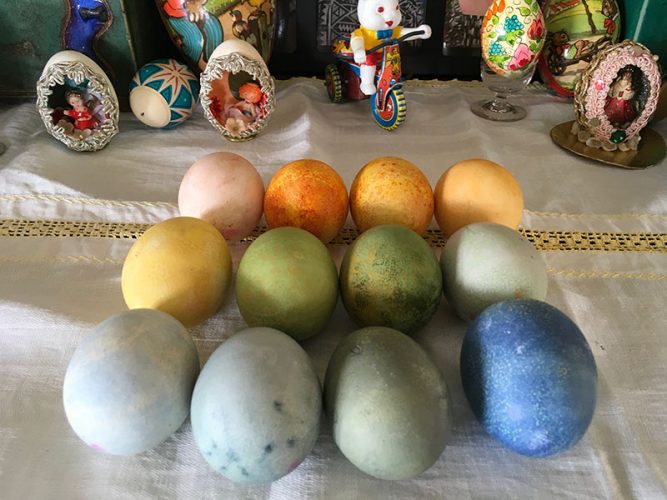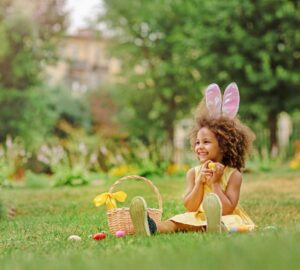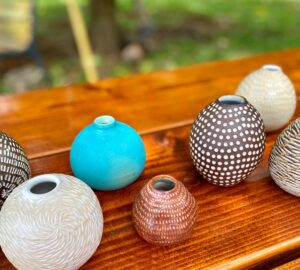
Native Hawaiian plants have many superpowers. One that is common to both native and introduced plants is that a huge number of species can be used to produce dyes. The Hawaiian art of kapa making is a launching point. Lisa Schattenburg-Raymond is an accomplished kapa maker, an expert in native Hawaiian dyes, and former director of Maui Nui Botanical Gardens. Lisa learned from her mother and has used the resources at the Garden to experiment and rediscover different colors. She shared some of her suggestions for using the plants around us when you are coloring eggs. Consider planting these in your garden so you’ll have plenty of dye materials for years to come.
Yellow – ‘Ōlena (Curcuma domestica), or turmeric can be used powdered or fresh. If powdered, try mixing with a few drops of olive oil and use a cloth to rub color onto the egg; or put fresh roots in a blender with water, boil, strain, and dip eggs.
Purple/Blue – ʻUki ʻuki (Dianella sandwicensis)* berries, when ripe, can be crushed and applied directly to eggshells, or boiled in a small amount of water to crush and break up the skin, then strained. Adding lime juice may make a truer blue. Hibiscus flowers such as Hau (Hibiscus tiliaceus) similarly boiled, or even the common red Hibiscus, can result in a blue color because of the alkaline nature of eggshells. Try crushing, heating, and straining purple cabbage, blueberries, or purple onion skins as well.
Green – Maʻo (Gossypium tomentosum) is in the word for green (ʻOmaʻo). The dried flowers of this Hawaiian cotton are used. It needs to sit and oxidize, or have a bit of wood ash or baking soda added to turn from yellow to green. Barely cover flowers with water and boil, then strain. Spinach leaves or pōpolo leaves may be used instead.
Red/Orange – ‘Alae’a or Hawaiian red clay can be mixed with oil and rubbed on for a rusty red. ʻĀkala (Rubus hawaiiensis) is the word for pink as well as the native Hawaiian rasberry. Crush and heat store bought raspberries to make pink, and leave the native ones alone unless you grow them. Annatto or achiote seeds mixed with a bit of oil and heated up can be applied with a cloth, for orange.
*Some berries in the genus, i.e., Dianella tasmanica and Dianella intermedia, are poisonous. The Hawaiian ʻuki ʻuki is not known to be toxic, but neither is it known to be edible.
Tamara Sherrill is the Executive Director of Maui Nui Botanical Gardens. You can see some of these plants and more at Maui Nui Botanical Gardens, open Tuesday through Saturday. Follow @mauinuibg to learn more.
See also: Easter Egg Dye with Vegetables



